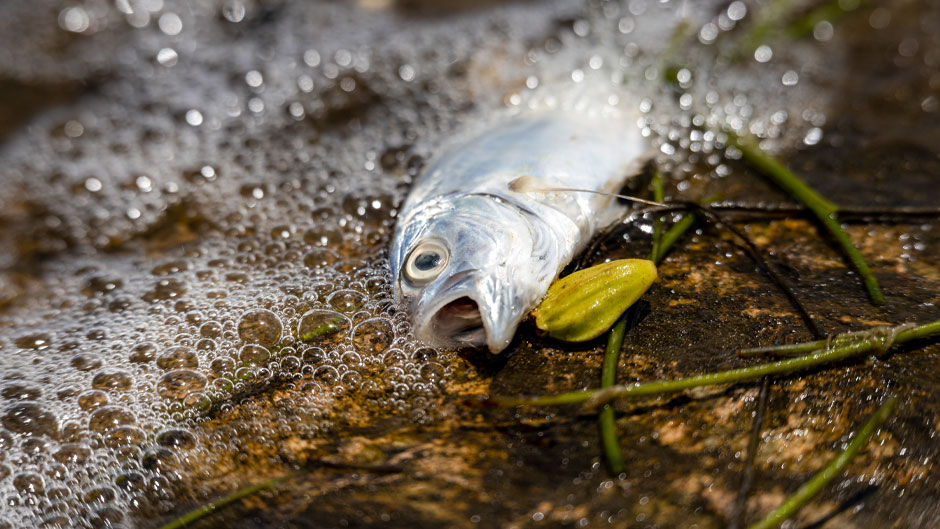Last Friday morning, Chris Langdon, an expert in ocean chemistry and professor of marine biology and ecology at the University of Miami Rosenstiel School of Marine and Atmospheric Science, received a call from Rachel Silverstein, a University alumna and executive director of the Miami Water Keeper. The call was about thousands of dead fish mysteriously floating around Biscayne Bay, largely in the vicinity between Morningside Park and 79th Street.
Within hours of that call, Langdon was out on his kayak with an oxygen sensor collecting data samples in order to understand what caused the incident. That morning he found that oxygen levels were high at a thin level near the surface. But a few inches below the surface, the oxygen dropped to an extremely low level and stayed at that level all the way to the bottom, which was about nine feet deep.
“This is where the majority of the fish live,” he said. “We think that anything below two milligrams of oxygen per liter is stressful to fish, because at that point they are not getting enough oxygen to feel comfortable and are left gasping. So, what they do is come to the surface where the oxygen levels are higher. But a lot of them still died from suffocation.”
The next day, Langdon set off on his kayak again. This time his data samples showed that there was a significant improvement in water quality after the Miami-Dade fire boats were deployed to help with aeration by spraying and moving the water around.
Now, the area has completely recovered. But Langdon said that he believes this event was caused as a result of warm temperatures and the dramatic increase of fresh water being discharged from the Little River into the North Biscayne Bay.
“We have data that measures how much water is flowing out each day, and it showed that the flow of fresh water out of this river into the bay has been twice the historical average,” he stated.
“The warm weather combined with little to no wind and watershed run off from the Little River about a quarter mile north, created a plume of nutrient rich, fresh water which caused the hypoxia,” said Langdon. “A blanket or warm fresh water on top of saltwater prevented normal mixing and oxygen from penetrating the water column.”
According to Langdon, hypoxia events historically occur during periods of very warm weather and low wind. Under normal circumstances, when the surface layer of the water heats up, stronger winds will cause the bay water to mix.
“When the surface water doesn’t mix well it causes what we call stratification,” he said. “Which means it's not going to mix with the layer below and as a result of that, it essentially turns off the supply of new oxygen to the water underneath where the fish live.”
The freshwater flowing out of the Little River is also much less dense than sea water, Langdon explained. Freshwater has zero salinity and does not mix well with the deeper water.
“So,” he added, “We have really a double whammy with hot days, low wind, and the amount of freshwater flowing out of the Little River. That explains why it's just in the vicinity of the Little River. If it was only because of the warm temperatures it would have affected the entire Biscayne Bay.”
Another reason so many fish died, Langdon noted, could be directly linked to the seagrass beds that have been dying off since 2013 and the worsening condition of the bay due to nutrient pollution.
“If the seagrass beds would have been in their healthy state, they could have prevented this offense or certainly ameliorated it by naturally producing oxygen from the bottom,” explained Langdon. “Instead of having to infuse oxygen into the water, these plants could have produced it through photosynthesis, and the bay could have healed itself. Everything is connected, and ecosystems can collapse when any link of the chain gets disrupted.”
According to Langdon, this incident can be prevented by offering guidelines to decision makers that outline the times of the year this is most likely to happen.
“We can look at historical data to identify the certain window of weeks in the summer when winds are the lowest and temperatures are the hottest and offer that information to the South Florida Water District. So, they can avoid or restrict the flow of fresh water into the bay and avoid the conditions that caused this event,” he said.
For long term solutions, Langdon encourages the public to continue playing their part in bringing these issues to the attention of city officials and to be mindful of the harmful fertilizers being used on their lawns that add to the current nutrient pollution issue in the bay.
Another long-term solution, Langdon pointed out, is for homes to transition from using septic tanks and connect to the city’s sewer system.
“Sea level rises overflow the cisterns and essentially flushes out sewage before the cisterns have an opportunity to break down bacteria,” he added. Those nutrients in the septic tanks eventually seep into the bay. We need to gradually get more homes connected to the sewer systems, because the sewage goes into treatment plants and then gets released more safely offshore.”

